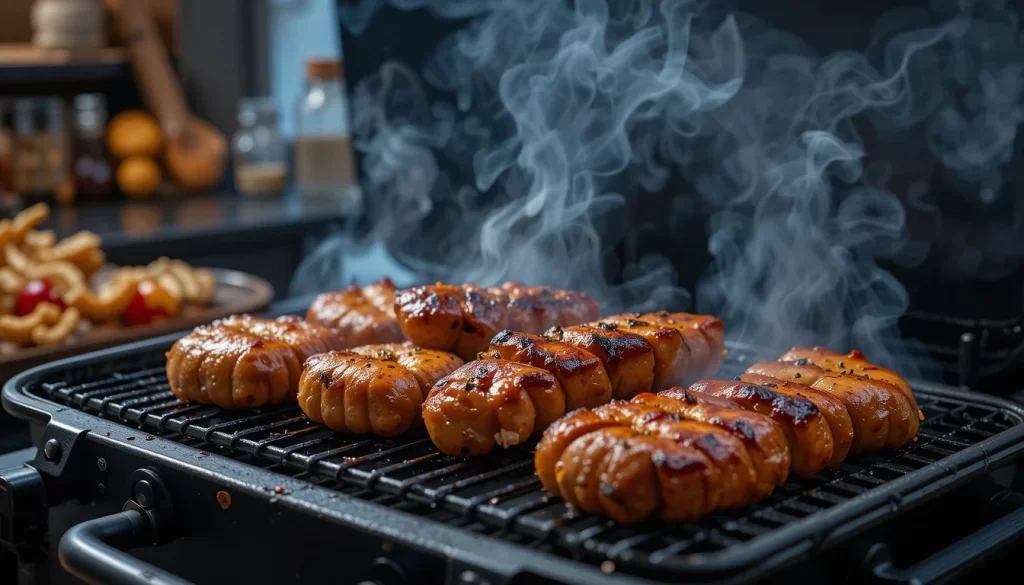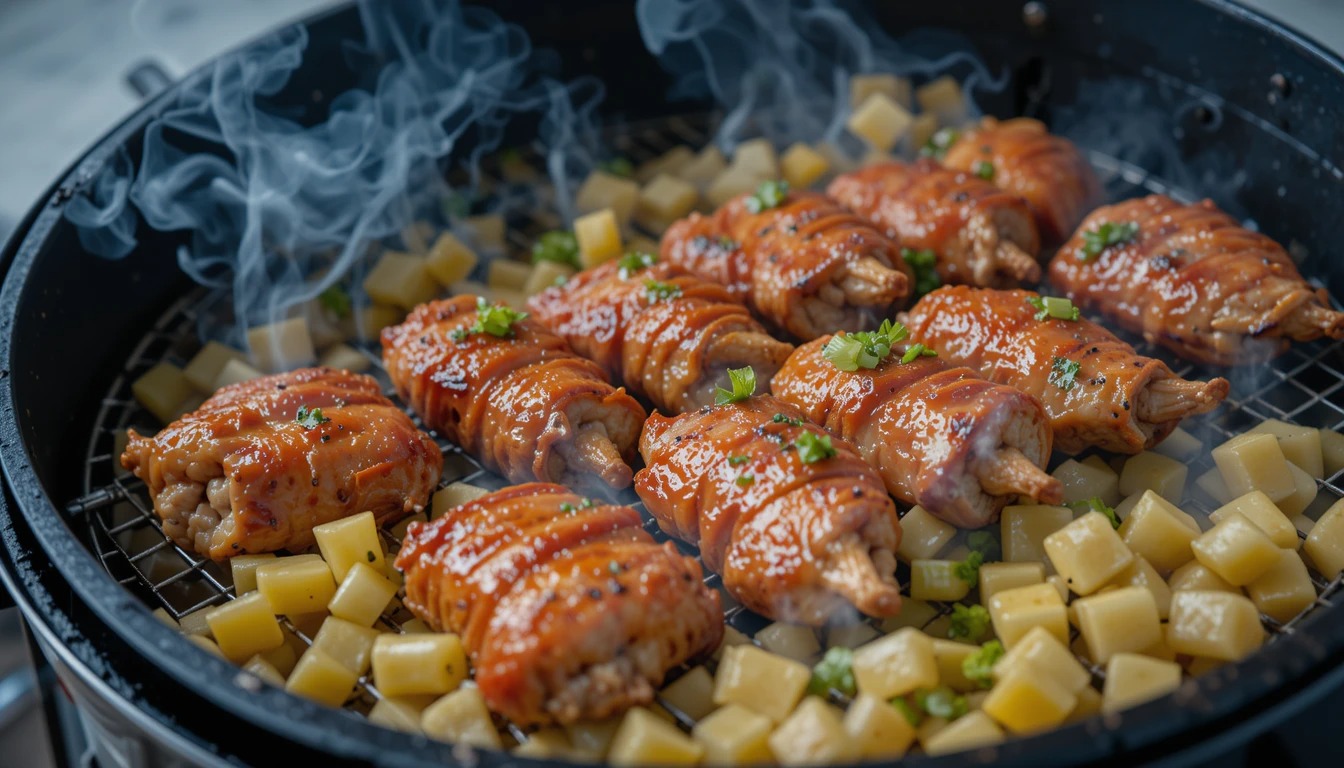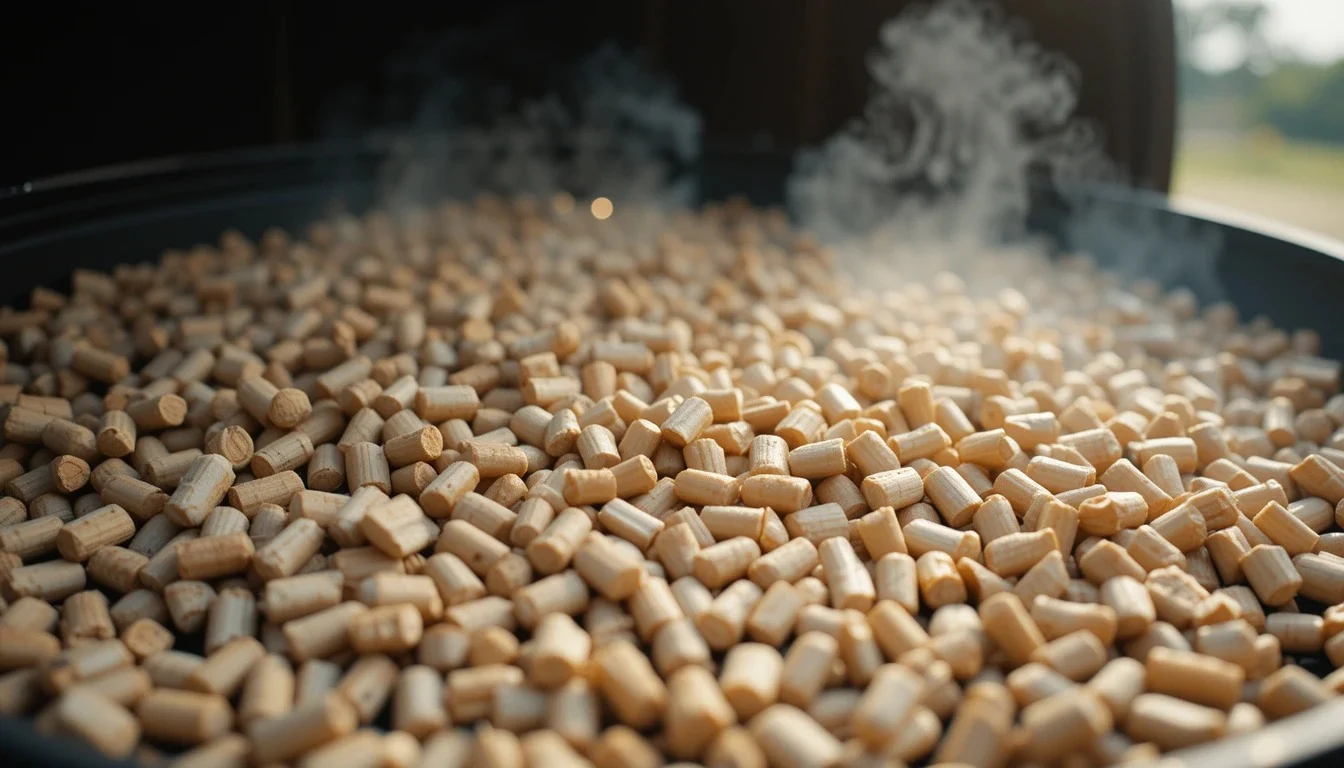Top 10 Portable Smokers for Mouthwatering BBQ On-the-Go in 2025

Ah, the tantalizing aroma of smoked meats wafting through the air! There’s nothing quite like it, is there? But who says you need a massive, stationary smoker to achieve BBQ perfection? Welcome to the world of portable smokers – your ticket to finger-licking goodness wherever your adventures take you! Whether you’re a tailgating enthusiast, a camping aficionado, or simply short on backyard space, these nifty devices are about to revolutionize your grilling game. Did you know that the portable smoker market is expected to grow by 5.2% annually through 2027? That’s right, folks – these compact culinary wizards are taking the BBQ world by storm! So, grab your apron and let’s dive into the sizzling world of portable smokers!
Types of Portable Smokers: Finding Your Perfect Match
Pellet Smokers: Convenient and Precise Temperature Control
Let me tell you, when I first got my hands on a pellet smoker, it was like stepping into the future of barbecue. These bad boys are all about convenience and precision. I remember spending countless weekends fiddling with charcoal and wood chips, trying to get that perfect smoke. But with a pellet smoker? It’s practically set-it-and-forget-it.
The beauty of pellet smokers lies in their auger-fed system. You just pour in your wood pellets, set the temperature, and let the smoker do its thing. It’s like having a little robot assistant that keeps your temperature steady and your meat smoky. I’ve found that it’s perfect for those long smokes when you don’t want to be babysitting your grill all day.
One time, I was hosting a big family reunion and decided to smoke a whole pork shoulder. With my pellet smoker, I was able to get it going early in the morning and actually enjoy time with my relatives instead of constantly checking on the meat. The result? Perfectly smoked pulled pork that had everyone asking for seconds.
But here’s the kicker – pellet smokers aren’t just for low and slow. Many models can crank up the heat for grilling too. It’s like having a Swiss Army knife of outdoor cooking. Just remember, these guys need electricity to run, so if you’re planning on truly remote smoking, you might want to consider other options.
Charcoal Smokers: Traditional Flavor and Affordability
Now, if you’re a purist like I used to be, charcoal smokers are where it’s at. There’s something about that authentic smoky flavor that just can’t be beat. And let’s be honest, the affordability factor is a big plus too. I started my smoking journey with a little bullet charcoal smoker, and it served me well for years.
Charcoal smokers require a bit more skill and attention, but that’s part of the fun. It’s like being a pit master in your own backyard. You get to play with fire, adjust vents, and really feel connected to the cooking process. I remember the first time I successfully maintained a steady temperature for a 12-hour brisket smoke. I felt like I had just won an Olympic gold medal!
One thing to keep in mind with charcoal smokers is that they can be a bit messy. You’ll be dealing with ash and sometimes unpredictable temperatures. But for many, including myself, that’s part of the charm. It’s not just about the end result; it’s about the journey of mastering your craft.
Electric Smokers: Easy to Use and Great for Beginners
Electric smokers are the gentle giants of the smoking world. They’re incredibly easy to use, making them perfect for beginners or folks who just want to smoke without the fuss. I’ve recommended electric smokers to several friends who were intimidated by the idea of maintaining a fire.
These smokers work by heating an element that causes wood chips to smolder, creating smoke. The temperature control is usually spot-on, which takes a lot of the guesswork out of smoking. I once used an electric smoker to make a batch of smoked cheese – something that requires very low temperatures. It turned out fantastic, and I didn’t have to stress about keeping the heat down.
The downside? Some BBQ enthusiasts argue that the flavor isn’t quite as rich as what you’d get from charcoal or wood. But in my experience, for most people, the difference is negligible, especially when you’re just starting out. Plus, being able to smoke in any weather condition without worrying about wind affecting your fire is a big plus.
Propane Smokers: Quick Heat-Up and Consistent Temperature
Propane smokers are like the middle ground between charcoal and electric. They offer the convenience of easy temperature control without needing an electrical outlet. I’ve found them to be particularly useful for tailgating or camping trips where electricity isn’t readily available.
These smokers heat up quickly and maintain a consistent temperature, which is great when you’re short on time or patience. I remember using a propane smoker for a last-minute neighborhood cookout. I was able to get it up to temperature and smoking in no time, and the ribs came out fall-off-the-bone tender.
One thing to keep in mind is that you’ll need to keep an eye on your propane levels. Running out of gas mid-smoke is a real bummer – trust me, I’ve been there. But as long as you’re prepared, propane smokers offer a great balance of convenience and flavor.
Offset Smokers: Dual-Purpose for Smoking and Grilling
Offset smokers, also known as stick burners, are the beasts of the smoking world. They’re not always the most portable, but some models are designed with mobility in mind. These smokers have a separate firebox attached to the main cooking chamber, allowing for indirect heat and smoke flow.
I’ll be honest, mastering an offset smoker took me some time. But once I got the hang of it, the results were incredible. The flavor you get from burning wood is unmatched, and the amount of control you have over the smoke is impressive. Plus, you can use the firebox as a direct heat source for grilling, making it a versatile piece of equipment.
One memorable cook I had with my offset smoker was a whole turkey for Thanksgiving. It took some planning and careful fire management, but the result was a beautifully bronzed bird with a subtle smoky flavor that had everyone at the table raving.
The downside? Offset smokers require a lot of attention and fuel. You’ll be adding wood or charcoal regularly to maintain temperature. But for many, including myself, that hands-on experience is part of the appeal.
Key Features to Consider When Choosing a Portable Smoker
Size and Weight: Ensure It’s Truly Portable for Your Needs
When I first started looking for a portable smoker, I made the mistake of not considering how I’d actually be transporting it. Trust me, lugging a 100-pound “portable” smoker up a hill for a beach cookout is not fun. Learn from my mistake and really think about where and how you’ll be using your smoker.
If you’re planning on tailgating or car camping, you might be able to handle something a bit larger and heavier. But if you’re looking to take your smoker on hiking trips or to the beach, you’ll want something lightweight and compact. I’ve found that some of the smaller pellet smokers or portable charcoal options work great for these situations.
Remember, portability isn’t just about weight. Consider things like wheels, handles, and how easy it is to break down and set up. I once bought a smoker that was lightweight but had no good way to carry it. Needless to say, it didn’t get much use on my outdoor adventures.
Cooking Capacity: Consider How Many People You’ll Typically Feed
This is where you need to be honest with yourself about your smoking habits. Are you usually cooking for just your family, or do you often host large gatherings? I’ve made the mistake of buying a smoker that was too small, and let me tell you, trying to smoke enough meat for a party in multiple batches is not ideal.
On the flip side, if you go too big, you might find yourself using more fuel than necessary for smaller cooks. I’ve found that a smoker that can handle about 20-25 pounds of meat is a good middle ground for most people. This gives you enough capacity for a couple of pork butts or a whole brisket, but isn’t overkill for smaller meals.
Don’t forget to consider the layout of the cooking area too. Some smokers have multiple racks, which can be great for smoking different types of food at once. I love being able to throw on some vegetables or appetizers while my main dish is smoking.
Fuel Type: Pellets, Charcoal, Electricity, or Propane
Choosing the right fuel type really comes down to personal preference and where you’ll be using your smoker. Each type has its pros and cons, and I’ve used them all at different times depending on the situation.
Pellets are great for convenience and precise temperature control, but you need electricity to run the auger and fan. Charcoal gives that classic smoky flavor but requires more attention. Electricity is super easy to use but you need a power source. Propane is portable and easy to control but you need to keep an eye on your gas levels.
I remember one camping trip where I brought my pellet smoker, only to realize there was no electricity available. Lesson learned! Now I always consider the fuel type in relation to where I’ll be smoking.
Temperature Range and Control: Look for Versatility in Cooking Options
Temperature control can make or break your smoking experience. Trust me, I’ve had my fair share of overcooked briskets and undercooked chickens due to poor temperature management. Look for a smoker that offers a wide temperature range and reliable control.
For low and slow smoking, you want to be able to maintain temperatures around 225°F to 250°F. But it’s also great to have the option to crank up the heat for things like chicken or even searing steaks. I love smokers that can go from 180°F all the way up to 500°F or more.
Some smokers come with built-in thermometers, but in my experience, these aren’t always accurate. I always use a separate digital thermometer to keep track of both the smoker temperature and the internal temperature of the meat. It’s a small investment that can save you from a lot of cooking mishaps.
Build Quality and Durability: Invest in a Smoker that Can Withstand Travel and Outdoor Use
When it comes to portable smokers, durability is key. These things are going to be bounced around in your car, exposed to the elements, and possibly dropped a time or two (not that I’m speaking from experience or anything…).
Look for smokers made with high-quality materials like stainless steel or heavy-gauge aluminum. Good insulation is also important, especially if you plan on smoking in colder weather. I once tried to smoke a turkey on a chilly November day with a poorly insulated smoker. Let’s just say it took a lot longer than it should have, and I went through way too much fuel trying to maintain temperature.
Don’t forget about the small details either. Things like sturdy latches, well-sealed doors, and rust-resistant grates can make a big difference in the longevity of your smoker. I’ve learned the hard way that skimping on quality usually ends up costing more in the long run when you have to replace your smoker sooner than expected.
Tips for Mastering Your Portable Smoker
Proper Seasoning: Break in Your Smoker Before First Use
Alright, let’s talk about seasoning your smoker. No, I don’t mean sprinkling it with salt and pepper (though that mental image is pretty funny). Seasoning is the process of preparing your smoker for its first use, and trust me, it’s not a step you want to skip.
When I got my first smoker, I was so excited that I wanted to throw a brisket on right away. Luckily, a wise old pitmaster at the store talked me out of it. Seasoning serves a few important purposes. First, it burns off any manufacturing residues or oils that might be lingering in your smoker. Second, it helps create a protective layer inside your smoker that will improve its performance and longevity.
To season your smoker, you’ll want to coat the interior with a high-heat cooking oil (I like to use canola oil), then run it at a high temperature for a couple of hours. Some people like to add wood chips during this process to really infuse that smoky flavor into the walls of the smoker. Just make sure you follow the manufacturer’s instructions, as the exact process can vary depending on the type of smoker you have.
Temperature Management: Learn to Maintain Consistent Heat
Temperature management is where the rubber meets the road in smoking. It’s also where I spent countless hours (and ruined a few cuts of meat) learning the ropes. The key is maintaining a consistent temperature throughout your cook.
For most low and slow smoking, you’re aiming for a temperature between 225°F and 250°F. This can be trickier than it sounds, especially with charcoal or wood smokers. I’ve found that small, frequent adjustments work better than big ones. It’s like steering a boat – gentle corrections keep you on course.
If you’re using a charcoal or wood smoker, get familiar with your vents. The intake vent controls how much oxygen gets to your fire, while the exhaust vent helps regulate temperature and smoke. As a general rule, open vents mean higher temperatures, closed vents mean lower temperatures.
For pellet, electric, or propane smokers, temperature management is usually easier thanks to built-in controls. But don’t get complacent! External factors like wind and ambient temperature can still affect your cook. I always keep a close eye on my smoker temp, even with these “set it and forget it” types.
Wood Selection: Experiment with Different Flavors
Choosing the right wood for smoking is like picking the perfect spice for a dish. It can really make or break your flavor profile. When I first started smoking, I thought all wood was created equal. Boy, was I wrong!
Different woods impart different flavors to your meat. Hickory and mesquite are strong and bold, great for beef and pork. Fruit woods like apple and cherry are milder and slightly sweet, perfect for poultry and fish. Oak is a good all-rounder that works with just about everything.
Don’t be afraid to experiment! Some of my best smokes have come from trying unusual wood combinations. I once smoked a turkey with a mix of apple and pecan wood that turned out absolutely fantastic.
Just remember, more smoke isn’t always better. Too much smoke can make your food bitter. I aim for a thin, blue smoke rather than thick, white billows. It took some practice, but getting that perfect smoke is so satisfying.
Moisture Control: Use Water Pans or Spritz Techniques
Moisture is crucial in smoking. It helps regulate temperature, prevents your meat from drying out, and can even help create that coveted smoke ring. But like many things in smoking, it’s all about balance.
Many smokers come with a water pan, and I highly recommend using it. Not only does it add moisture to your smoking environment, but it also helps stabilize the temperature. I like to experiment with what I put in the water pan too. Sometimes I’ll add apple juice or beer for extra flavor.
Spritzing is another technique I love. Every hour or so, I’ll spray my meat with a mixture of apple cider vinegar and water. It helps keep the surface moist and can add a nice tang to the final product. Just be careful when opening your smoker – you don’t want to let out too much heat or smoke.
Cleaning and Maintenance: Keep Your Smoker in Top Condition for Longevity
I’ll be the first to admit, cleaning a smoker isn’t the most fun part of barbecue. But trust me, it’s worth it. A well-maintained smoker will last longer and perform better cook after cook.
After each use, I make sure to clean out any ash or leftover pellets. For charcoal and wood smokers, I’ll brush down the grates while they’re still warm (but not hot!) – it’s much easier than trying to scrub off cold, caked-on grime.
Every few cooks, I’ll do a deeper clean. This involves scraping down the inside walls and giving everything a good wash. Just be careful not to scrub off that nice seasoning you’ve built up!
Don’t forget about the outside of your smoker too. A quick wipe down can prevent rust and keep your smoker looking good. I learned this lesson the hard way after leaving my first smoker out in the rain one too many times.
Lastly, always check your smoker for any damage or wear before each use. Replace any worn-out parts promptly. A little preventative maintenance goes a long way in extending the life of your smoker.
Remember, a clean smoker is a happy smoker, and a happy smoker makes delicious food!
Conclusion
There you have it, BBQ enthusiasts – the lowdown on portable smokers that’ll have you smoking up a storm wherever life takes you! From compact pellet powerhouses to traditional charcoal champs, there’s a portable smoker out there with your name on it. So why wait? It’s time to elevate your outdoor cooking game and become the grill master you’ve always dreamed of being. Remember, great BBQ isn’t just about the equipment – it’s about passion, patience, and a willingness to experiment. So fire up that portable smoker, gather your friends and family, and create some mouthwatering memories. Happy smoking, everyone!
FAQ
- Are portable smokers as effective as full-sized ones?
Absolutely! While they may have smaller capacities, many portable smokers can produce results just as delicious as their larger counterparts. - How long does it take to smoke meat in a portable smoker?
It varies depending on the meat and smoker type, but generally, expect 1-2 hours per pound of meat. - Can I use a portable smoker indoors?
No! Always use smokers outdoors in well-ventilated areas to avoid fire hazards and carbon monoxide buildup. - What’s the best fuel for portable smokers?
It depends on your preference. Pellets offer convenience, charcoal provides traditional flavor, while propane and electric options are user-friendly. - How do I clean my portable smoker?
Clean after each use by scraping grates, emptying ash, and wiping down surfaces. Deep clean periodically with soap and water.


